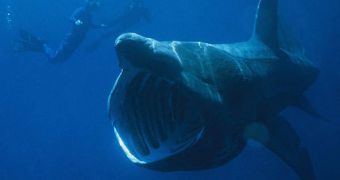The basking shark is the second-largest shark in the world, being able to grow up to 33 feet (about ten meters) in length. It travels a wide area of the world's oceans, with its very wide mouth opening almost never closed. It filters 500,000 gallons of water each hour, and extracts from it its main source of food, plankton. This peculiar and very rare animal has come under intense scrutiny over the past few decades, but only during the summer. That is to say, every winter the animals pulled nothing less than a disappearance act, making themselves invisible to researchers until the next summer.
Because they simply vanished from one day to the other, marine biologists have set forth a number of hypotheses of what could be the cause of their absence. Some have even theorized that the animals fall on the ocean floor and hibernate during the winter, even though it's pretty clear to anyone who knows anything about mammals and fish that it's impossible for sharks to hibernate. Now, a group of scientists from the Massachusetts Division of Marine Fisheries, led by Aquatic Biologist Greg Skomal, have finally managed to crack the half-a-century-old mystery, Wired reports.
“It’s been a big mystery for the past fifty years. For a while, people thought they were hibernating on the sea floor, even though hibernating is not really something sharks do,” Skomal said. He is also the lead author of a new study detailing the finds, published in the May 7th issue of the journal Current Biology. Leading the team West of Cape Cod, Massachusetts, Skomal managed to tag a basking shark with a GPS location device, which allowed the researchers to constantly monitor the fish's position.
During winter months, the signals appeared to have stabilized in the Caribbean, hinting at the fact that the large animals had a secret “hideout,” where they spent the cold period. In addition, some pack members were identified as traveling as far South as the Brazilian coast, which was really unexpected for the marine biologists involved in the study. A large part of the surveyed pack was also found to spend months outside their known spread range.
Their behavior was assessed with a special type of sensors, which was able to store both the duration of travel, depth of swim, as well as other features. After a preset time frame passes, the sensors come off the fish and reach the surface, where they immediately transmit all data to the scientists via satellite. Such devices showed that it was not uncommon for the sharks to dive to more than 3,000 feet, on occasions, and to remain submerged at that depth for several months on end.

 14 DAY TRIAL //
14 DAY TRIAL //